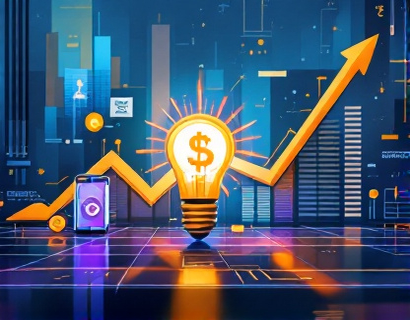Revolutionizing Digital Asset Management: The Rise of Decentralized dApps for Cross-Blockchain Compatibility
The blockchain ecosystem has witnessed a significant shift towards decentralization, particularly in the management of digital assets. Traditional methods of handling cross-blockchain transactions have been cumbersome, often requiring intermediaries and complex workflows. This has led to the emergence of decentralized applications (dApps) that promise to streamline these processes, offering a more efficient, secure, and user-friendly experience. One such innovation is a cutting-edge dApp designed to revolutionize cross-blockchain digital asset management, providing a seamless solution for blockchain professionals and digital asset managers.
The need for a decentralized platform that can handle cross-blockchain conversions without the hassle of intermediaries is more pressing than ever. As the number of blockchains and their respective ecosystems grows, the complexity of managing digital assets across different platforms increases exponentially. This has given rise to a solution that not only simplifies the conversion process but also ensures compatibility and security, making it an indispensable tool for anyone involved in the blockchain space.
Understanding the Challenges of Cross-Blockchain Asset Management
Cross-blockchain asset management involves transferring digital assets from one blockchain to another, a process fraught with challenges. Each blockchain has its unique protocols, consensus mechanisms, and data structures, making direct asset transfer a non-trivial task. Traditional methods often rely on centralized exchanges or bridges, which can introduce risks such as single points of failure, higher transaction fees, and longer processing times. Moreover, these centralized solutions may not always ensure the integrity and security of the assets during transfer.
The decentralized approach offered by the new dApp addresses these issues head-on. By leveraging smart contracts and decentralized networks, the platform eliminates the need for intermediaries, reducing costs and enhancing security. The dApp is designed to work across multiple blockchains, providing a unified interface for users to manage their assets without the complexity of navigating different ecosystems.
Key Features of the Decentralized dApp
The dApp in question boasts several key features that set it apart from existing solutions:
- Seamless Cross-Blockchain Transfers: The platform allows users to transfer assets between different blockchains with ease, supporting a wide range of cryptocurrencies and tokens. This interoperability is achieved through a robust network of decentralized nodes and smart contracts that facilitate smooth asset movement.
- Enhanced Security: Security is paramount in the blockchain space, and this dApp prioritizes it at every step. Transactions are encrypted and verified through decentralized consensus mechanisms, ensuring that assets are safely transferred without the risk of tampering or hacking.
- User-Friendly Interface: Despite its complexity, the dApp is designed with the user in mind. A intuitive interface guides users through the asset transfer process, making it accessible even to those with limited technical knowledge.
- Real-Time Tracking: Users can monitor the status of their asset transfers in real-time, receiving updates on transaction progress and completion. This transparency builds trust and provides peace of mind.
- Cost Efficiency: By eliminating intermediaries, the dApp significantly reduces transaction fees, making cross-blockchain transfers more affordable. This cost efficiency is particularly beneficial for small traders and institutional investors who frequently engage in cross-blockchain activities.
Technical Underpinnings of the dApp
The technical architecture of the dApp is built on a foundation of decentralized technologies, ensuring scalability, reliability, and security. Here’s a deeper look into the components that make this platform possible:
Firstly, the dApp utilizes a layer 2 scaling solution to handle a high volume of transactions without compromising on speed or security. This approach offloads some of the processing work from the main blockchain, reducing congestion and lowering transaction costs. The platform also employs a multi-chain atomic swap protocol, allowing for direct asset swaps between different blockchains without the need for intermediate exchanges.
Smart contracts play a crucial role in the dApp’s functionality. These self-executing contracts with the terms directly written into code ensure that each step of the asset transfer process is executed precisely as intended. The smart contracts are deployed on trusted blockchain networks, adding an extra layer of security and trustworthiness to the system.
Interoperability is achieved through a combination of standardized protocols and cross-chain bridges. These bridges connect different blockchain networks, enabling the seamless transfer of assets. The dApp integrates with multiple bridges, ensuring compatibility with a wide range of blockchains, from Ethereum and Binance Smart Chain to newer platforms like Solana and Polkadot.
Use Cases and Benefits
The benefits of using this decentralized dApp are manifold, making it a valuable tool for various stakeholders in the blockchain ecosystem:
For blockchain developers, the dApp provides a reliable and efficient way to test and deploy applications across multiple blockchains. Developers can leverage the platform to manage assets and conduct cross-chain testing, streamlining their development workflow and reducing the time to market for their projects.
For institutional investors, the platform offers a secure and cost-effective solution for managing diverse portfolios. Institutional players can easily transfer assets between blockchains, optimizing their investment strategies and minimizing exposure to high fees and delays associated with traditional methods.
For individual traders, the dApp democratizes access to cross-blockchain trading. Users can participate in decentralized finance (DeFi) opportunities, swap tokens, and engage in various financial activities without the need for complex setup processes or high transaction costs.
Moreover, the platform fosters a more decentralized and inclusive blockchain ecosystem. By reducing reliance on centralized exchanges and intermediaries, the dApp empowers users to have greater control over their assets and transactions, aligning with the core principles of blockchain technology.
Future Prospects and Challenges
As the blockchain landscape continues to evolve, the dApp is poised to play a significant role in shaping the future of digital asset management. However, there are several challenges that need to be addressed to ensure its widespread adoption:
Firstly, scalability remains a critical issue. While layer 2 solutions and multi-chain atomic swaps help, the platform must continue to innovate to handle increasing transaction volumes without compromising performance.
Secondly, regulatory compliance is a growing concern. As governments around the world start to regulate cryptocurrencies and blockchain technologies, the dApp must navigate these regulations to operate legally and securely in different jurisdictions.
Thirdly, user education is essential. Despite the user-friendly interface, many potential users may still be unfamiliar with blockchain concepts. Providing comprehensive educational resources and support can help bridge this gap and attract a broader user base.
Lastly, network security must be a top priority. While the use of decentralized consensus mechanisms and smart contracts enhances security, continuous monitoring and updates are necessary to protect against emerging threats and vulnerabilities.
Conclusion
The introduction of a decentralized dApp for cross-blockchain digital asset management represents a significant leap forward in the blockchain ecosystem. By addressing the key challenges of interoperability, security, and user experience, this platform offers a robust solution for blockchain professionals and enthusiasts alike. As the technology matures and more users adopt decentralized solutions, the dApp is well-positioned to become a cornerstone of the decentralized finance and asset management landscape.











































